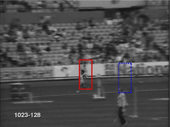Highlight
Noise resistant computer vision
Achievement/Results
NSF funded researchers Hamed Masnadi-Shirazi and Nuno Vasconcelos in collaboration with Vijay Mahadevan, while working at the University of California San Diego, have derived a novel loss function, denoted as the Tangent loss which can contend with the noisy and outlier ridden datasets typical of computer vision. A noise and outlier resistant classification algorithm (TangentBoost) is also derived utilizing the aforementioned loss function. This classification algorithm was then tested on a variety of computer vision problems such as object tracking, scene classification and object recognition and shown to produce state of the art results. The first figure shows two video frames from the task of tracking a running athlete. This is an example of where a non-robust tracking algorithm loses track of the runner (dotted blue box) while the proposed robust tracking algorithm remains centered on the runner (solid red box). The principles of classifier loss function design and probability elicitation from machine learning were previously published by Hamed Masnadi-Shirazi and Nuno Vasconcelos as a 2008 NIPS paper. These principles are applied to the design of robust losses and it is argued that such robustness requires loss functions that penalize both large positive and negative margins. The second figure plots the Tangent loss along with previous non-robust loss function for comparison. The probability elicitation view of classifier design is adopted, and a set of necessary conditions for the design of such losses is identified. The insights gained from the subject of loss function design in machine learning has allowed for the design of outlier resistant and robust classification algorithms that produce state of the art results in computer vision. This serves as a prime example of how the research areas of machine learning and computer vision are closely related. These results have been accepted for publication in IEEE-CVPR 2010.
Address Goals
Making computer vision more robust and less sensitive to noise (more human-like) has broad impact for many applications. This research is part of the dissertation work of graduate student Hamed Masnadi-Shirazi.








